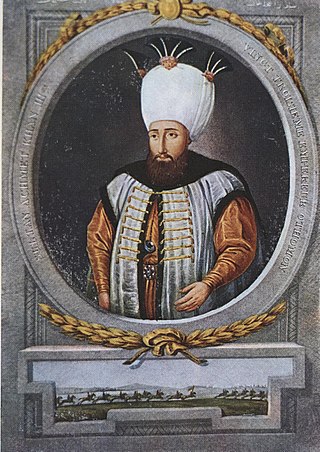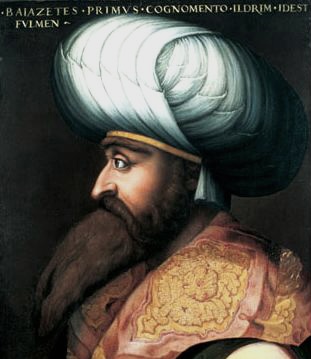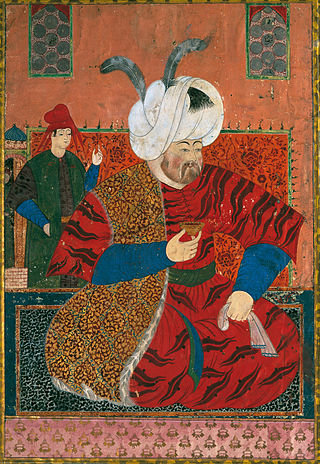Related Research Articles

Ahmed III was sultan of the Ottoman Empire and a son of sultan Mehmed IV. His mother was Gülnuş Sultan, originally named Evmania Voria, who was an ethnic Greek. He was born at Hacıoğlu Pazarcık, in Dobruja. He succeeded to the throne in 1703 on the abdication of his brother Mustafa II (1695–1703). Nevşehirli Damat İbrahim Pasha and the Sultan's daughter, Fatma Sultan directed the government from 1718 to 1730, a period referred to as the Tulip Era.

Bayezid I, also known as Bayezid the Thunderbolt, was the sultan of the Ottoman Empire from 1389 to 1402. He adopted the title of Sultan-i Rûm, Rûm being the Arabic name for the Eastern Roman Empire. In 1394, Bayezid unsuccessfully besieged Constantinople. He defeated the Crusaders at the Battle of Nicopolis in what is now Bulgaria in 1396. He was later defeated and captured by Timur at the Battle of Ankara in 1402 and died in captivity in March 1403, which triggered the Ottoman Interregnum.

Bayezid II was the sultan of the Ottoman Empire from 1481 to 1512. During his reign, Bayezid consolidated the Ottoman Empire, thwarted a Safavid rebellion and finally abdicated his throne to his son, Selim I. Bayezid evacuated Sephardi Jews from Spain after the proclamation of the Alhambra Decree and resettled them throughout Ottoman lands, especially in Salonica.

Mehmed III was the sultan of the Ottoman Empire from 1595 until his death in 1603. Mehmed was known for ordering the execution of his brothers and leading the army in the Long Turkish war, during which the Ottoman army was victorious at the decisive Battle of Keresztes. This victory was however undermined by some military losses such as in Gyor and Nikopol. He also ordered the successful quelling of the Jelali rebellions. The sultan also communicated with the court of Elizabeth I on the grounds of stronger commercial relations and in the hopes of England to ally with the Ottomans against the Spanish.

Murad IV was the sultan of the Ottoman Empire from 1623 to 1640, known both for restoring the authority of the state and for the brutality of his methods. Murad IV was born in Constantinople, the son of Sultan Ahmed I and Kösem Sultan. He was brought to power by a palace conspiracy when he was just 11 years old, and he succeeded his uncle Mustafa I. Until he assumed absolute power on 18 May 1632, the empire was ruled by his mother, Kösem Sultan, as nāʾib-i salṭanat (regent). His reign is most notable for the Ottoman–Safavid War, of which the outcome would partition the Caucasus between the two Imperial powers for around two centuries, while it also roughly laid the foundation for the current Turkey–Iran–Iraq borders.

Selim II, also known as Selim the Blond or Selim the Drunk, was the sultan of the Ottoman Empire from 1566 until his death in 1574. He was a son of Suleiman the Magnificent and his wife Hurrem Sultan. Selim had been an unlikely candidate for the throne until his brother Mehmed died of smallpox, his half-brother Mustafa was strangled to death by the order of his father, his brother Cihangir succumbed to chronic health issues, and his brother Bayezid was killed on the order of his father after a rebellion against Selim. Selim died on 15 December 1574 and was buried in Hagia Sophia.

Malik-Shah I, was the third sultan of the Seljuk Empire from 1072 to 1092, under whom the sultanate reached its zenith of power and influence.

Shah Rukh or Shahrukh Mirza was the ruler of the Timurid Empire between 1405 and 1447.

Al-Malik an-Nasir Nasir ad-Din Muhammad ibn Qalawun, commonly known as an-Nasir Muhammad, or by his kunya: Abu al-Ma'ali or as Ibn Qalawun (1285–1341) was the ninth Mamluk sultan of the Bahri dynasty who ruled Egypt between 1293–1294, 1299–1309, and 1310 until his death in 1341. During his first reign he was dominated by Kitbugha and al-Shuja‘i, while during his second reign he was dominated by Baibars and Salar. Not wanting to be dominated or deprived of his full rights as a sultan by his third reign, an-Nasir executed Baibars and accepted the resignation of Salar as vice Sultan.

Shibli Nomani was an Islamic scholar, poet, philosopher, historian, educational thinker, author, orator, reformer and critic of orientalists from Indian subcontinent during the British Raj. He is regarded as the father of Urdu historiography. He was also proficient in Arabic and Persian languages. Shibli was associated with two influential movements in the region, the Aligarh and the Nadwa movements. As a supporter of the Deobandi school, he believed that English language and European sciences should be incorporated into the education system. Shibli wrote several biographies of Muslim heroes, convinced that Muslims of his time could learn valuable lessons from the past. His synthesis of past and modern ideas contributed significantly to Islamic literature produced in Urdu between 1910 and 1935. Shibli established the Darul Musannefin Shibli Academy in 1914 to promote Islamic scholarship and also founded the Shibli National College in 1883. Although he collected much material on the life of Prophet Muhammad, he could only complete the first two volumes of the planned work, Sirat al-Nabi. His disciple, Sulaiman Nadvi, added to this material and wrote the remaining five volumes after Shibli's death.

The Sultanate of Maguindanao was a sultanate that ruled parts of the island of Mindanao, in the southern Philippines, especially in modern-day Maguindanao provinces, Soccsksargen, Zamboanga Peninsula and Davao Region. Its known historical influence stretches from the peninsula of Zamboanga to the bay of Sarangani. During the era of European colonization, the Sultanate maintained friendly relations with British and Dutch traders.

Peureulak Sultanate or Perlak Sultanate is the earliest sultanate in Southeast Asia, believed to have converted to Islam as early as the 9th century. The location of Peureulak is in what is now the East Aceh Regency, Indonesia.
Sultan Muwallil Wasit, is the 9th Sultan of Sulu and was also known as Rajah Bongsu I. His birth name was Pangiran Shahbandar Maharajalela, and was the youngest son of former Sultan of Brunei Muhammad Hassan. He reigned in Sulu after his uncle, Sultan Batara Shah Tengah died without an heir. He was most likely sent to Sulu to end dynastic troubles there, as he was begot of the marriage of Batara Tengah's Sister, and the Sultan of Brunei. On his coming to Sulu in 1609, he was brought by his father Sultan Muhammad Hassan brought along with his royal symbol's called as "Pulau Janggi" and "Sepong Janggi". This royal symbol was a symbol of brotherhood between the Sultanate of Sulu and the Sultanate of Brunei and as a royal proof that Raja Bongsu-I really belonged to the royal family of Brunei.
Qāḍī Sayyid Rāfiʿ Muḥammad Dasondhi was a scholar of repute from Sakras, District Gurgaon. He belonged to the family of Gardēzī Sadaat.
Kapitan Laut Buisan, also known as Datu Katchil or Sultan Laut Buisan, was the sixth Sultan of Maguindanao in the Philippines. He was a direct descendant of Shariff Kabungsuwan, a Muslim missionary who preached Islam in the Philippines and established the sultanate after marrying a Sulu princess in the 16th century.

Gevherhan Sultan was an Ottoman princess, daughter of Sultan Ahmed I and Kösem Sultan, half-sister of Sultan Osman II, and sister of Sultans Murad IV (1623–1640) and Ibrahim of the Ottoman Empire.
The Spanish occupation of Jolo or Battle of Jolo was a military expedition in the 1630s to pacify the Moro of the Sulu Sultanate. The expedition, personally led by Sebastian de Corcuera, the then Governor-General of the Spanish East Indies was a follow-up expedition to the earlier successful campaigns against the Maguindanao Sultanate under Sultan Qudarat. It was initially successful, partly due to an epidemic within the Sultan Wasit's fort early in the campaign, resulting in the Sulu forces retreating to Tawi-Tawi.

Selim I, known as Selim the Grim or Selim the Resolute, was the sultan of the Ottoman Empire from 1512 to 1520. Despite lasting only eight years, his reign is notable for the enormous expansion of the Empire, particularly his conquest between 1516 and 1517 of the entire Mamluk Sultanate of Egypt, which included all of the Levant, Hejaz, Tihamah and Egypt itself. On the eve of his death in 1520, the Ottoman Empire spanned about 3.4 million km2 (1.3 million sq mi), having grown by seventy percent during Selim's reign.
Sultan Gugu Sarikula was the fifth sultan of Maguindanao in the Philippines. Sarikula was a direct descendant of Sharif Kabungsuwan, the first sultan of Maguindanao. He was the son of Sultan Bangkaya with his Matampay wife. Sarikula also had half brothers, Dimasangcay Adel and Buisan, who also reigned as sultans of Maguindanao before and after him.
Mihrimah Sultan was an Ottoman princess, daughter of Sultan Murad III and Safiye Sultan, and sister of Sultan Mehmed III of the Ottoman Empire.
References
- 1 2 Syed, Muzaffar Husain; Akhtar, Syed Saud; Usmani, B.D. (2011). Concise History of Islam. Vij Books India Pvt Ltd. p. 329. ISBN 978-93-82573-47-0.
- 1 2 3 "Dansalan Quarterly". Dansalan Quarterly. Vol. 1–4. Dansalan Research Center. 1979. p. 76. Retrieved 2023-09-05.
- 1 2 Haerens, Margaret (2014). Mixed Marriage. Greenhaven Publishing LLC. p. 104. ISBN 978-0-7377-6266-2.
- 1 2 Foreman, John (1892). The Philippine Islands. Vol. 1. Library of Alexandria. ISBN 978-1-4655-2140-8.